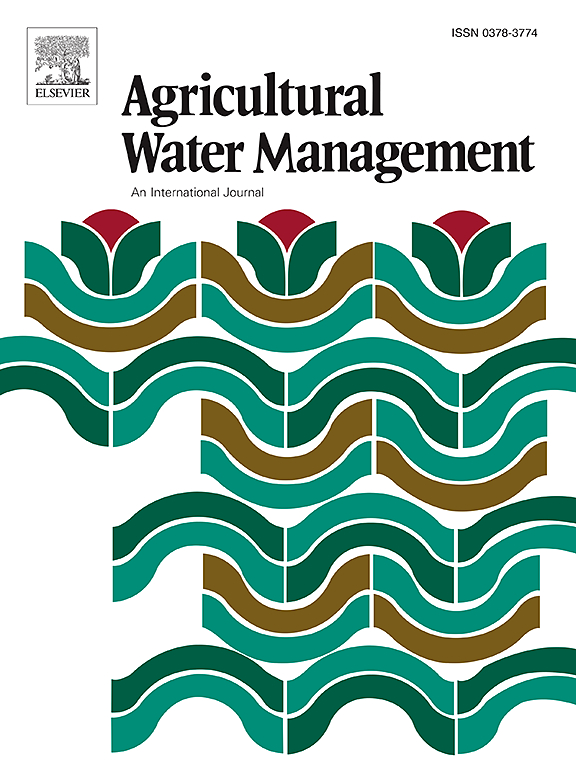四个小麦-玉米轮作季节中不同灌溉模式对土壤微生物群落特征和酶活性的影响
IF 5.9
1区 农林科学
Q1 AGRONOMY
引用次数: 0
摘要
干旱和半干旱地区的缺水问题凸显了开发节水灌溉技术的重要性。土壤胞外酶活性(EEAs)和微生物对土壤生化循环和植物生长非常重要。然而,人们对土壤 EEAs 和微生物群落如何响应节水灌溉系统和水平知之甚少。因此,在连续四季的小麦-玉米田间试验中,探讨了地表灌溉(SI)和滴灌(DI)结合不同灌溉水平(即 65、50、35 和 20 毫米/次,分别代表充足灌溉、轻度亏缺灌溉、中度亏缺灌溉和严重亏缺灌溉)对植物生物量、土壤性质、土壤 EEAs 和细菌群落的影响。结果表明,与充足灌溉相比,轻度亏缺灌溉对植物生物量没有显著影响,严重亏缺灌溉和中度亏缺灌溉使作物生物量分别显著减少了 49.0% 和 26.6%。然而,在 DI 条件下,严重和中度亏缺灌溉的作物生物量分别比 SI 条件下高 15.4 % 和 17.4 %。严重和中度亏缺灌溉显著增加了土壤可利用钾的积累和土壤脲酶活性,降低了细菌丰富度,并改变了细菌群落结构。轻度亏缺灌溉和充分灌溉之间无明显差异。在严重亏缺灌溉条件下,固氮菌群、革囊菌群和粘球菌群的相对丰度明显增加,而酸性杆菌群则明显减少。DI 条件下的中度亏缺灌溉没有改变细菌群落结构,而 SI 条件下则有所改变。土壤 pH 值、导电率(EC)、可利用钾和植物生物量是影响细菌群落组成的主要因素。严重亏缺灌溉降低了土壤细菌共生网络的复杂性和稳定性。DI 网络中细菌之间的相互作用比 SI 更为显著。因此,直接灌溉加上适度亏缺灌溉比直接灌溉更有利于保持作物产量和细菌群落结构的稳定性。本文章由计算机程序翻译,如有差异,请以英文原文为准。
Responses of soil microbial community characteristics and enzyme activities to different irrigation modes over four wheat-maize rotation seasons
Water scarcity in arid and semiarid areas highlights the importance of developing water-saving irrigation techniques. Soil extracellular enzyme activities (EEAs) and microbes are important for soil biochemical cycles and plant growth. However, little is understood about how soil EEAs, and microbial communities respond to water-saving irrigation systems and levels. Therefore, a field experiment was carried out over four consecutive wheat-maize seasons to explore the effects of surface irrigation (SI) and drip irrigation (DI) coupled with different irrigation levels (i.e. 65, 50, 35 and 20 mm/event, represents sufficient, mild deficit, moderate deficit and serious deficit irrigation, respectively) on the plant biomass, soil properties, soil EEAs, and bacterial community. The results revealed that mild deficit irrigation showed no significant impact on plant biomass, serious and moderate deficit irrigation significantly decreased crop biomass by 49.0 % and 26.6 %, respectively, compared with sufficient irrigation. However, the crop biomass of serious and moderate deficit irrigation under DI were 15.4 % and 17.4 % higher, respectively, than that under SI. Serious and moderate deficit irrigation significantly increased soil available K accumulation and soil urease activity, decreased bacterial richness, and shifted the bacterial community structure. No significant differences were found between mild deficit and sufficient irrigation. The relative abundances of Firmicutes, Gemmatimonadota, and Myxococcota significantly increased under serious deficit irrigation, while Acidobacteriota significantly decreased. Moderate deficit irrigation under DI did not shift bacterial community structure, while under SI did. Soil pH, electrical conductivity (EC), available K, and plant biomass were the major factors influencing the bacterial community compositions. Serious deficit irrigation reduced the complexity and stability of the soil bacterial co-occurrence network. The network of DI had more significant interactions among bacteria than the SI. Therefore, DI coupled with moderate deficit irrigation is more beneficial to maintain crop yield and the stability of bacterial community structure than SI.
求助全文
通过发布文献求助,成功后即可免费获取论文全文。
去求助
来源期刊

Agricultural Water Management
农林科学-农艺学
CiteScore
12.10
自引率
14.90%
发文量
648
审稿时长
4.9 months
期刊介绍:
Agricultural Water Management publishes papers of international significance relating to the science, economics, and policy of agricultural water management. In all cases, manuscripts must address implications and provide insight regarding agricultural water management.
 求助内容:
求助内容: 应助结果提醒方式:
应助结果提醒方式:


